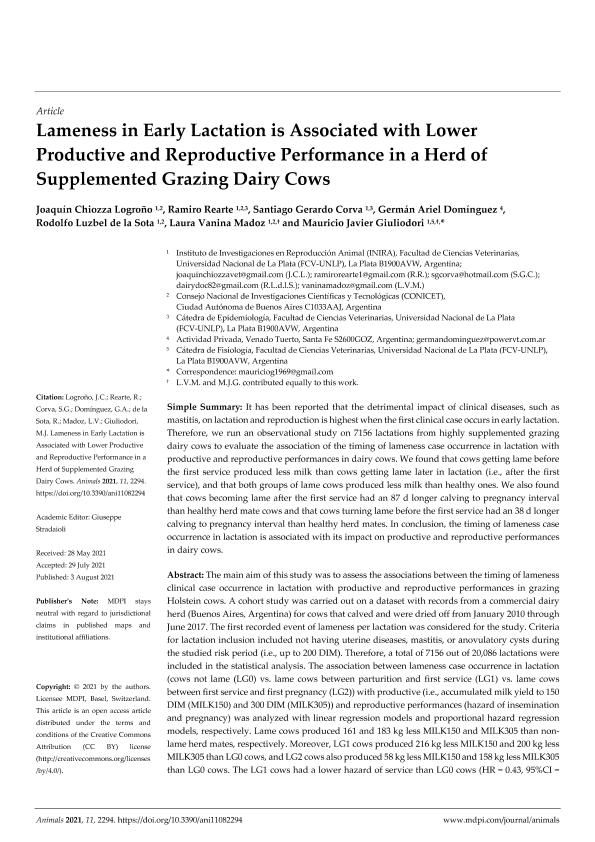Mostrar el registro sencillo del ítem
dc.contributor.author
Chiozza Logroño, Joaquin

dc.contributor.author
Rearte, Ramiro

dc.contributor.author
Corva, Santiago Gerardo

dc.contributor.author
Domínguez, Germán Ariel
dc.contributor.author
de la Sota, Rodolfo Luzbel

dc.contributor.author
Madoz, Laura Vanina

dc.contributor.author
Giuliodori, Mauricio Javier

dc.date.available
2022-02-01T10:02:35Z
dc.date.issued
2021-08
dc.identifier.citation
Chiozza Logroño, Joaquin; Rearte, Ramiro; Corva, Santiago Gerardo; Domínguez, Germán Ariel; de la Sota, Rodolfo Luzbel; et al.; Lameness in early lactation is associated with lower productive and reproductive performance in a herd of supplemented grazing dairy cows; Multidisciplinary Digital Publishing Institute; Animals; 11; 8; 8-2021; 1-10
dc.identifier.issn
2076-2615
dc.identifier.uri
http://hdl.handle.net/11336/151034
dc.description.abstract
The main aim of this study was to assess the associations between the timing of lameness clinical case occurrence in lactation with productive and reproductive performances in grazing Holstein cows. A cohort study was carried out on a dataset with records from a commercial dairy herd (Buenos Aires, Argentina) for cows that calved and were dried off from January 2010 through June 2017. The first recorded event of lameness per lactation was considered for the study. Criteria for lactation inclusion included not having uterine diseases, mastitis, or anovulatory cysts during the studied risk period (i.e., up to 200 DIM). Therefore, a total of 7156 out of 20,086 lactations were included in the statistical analysis. The association between lameness case occurrence in lactation (cows not lame (LG0) vs. lame cows between parturition and first service (LG1) vs. lame cows between first service and first pregnancy (LG2)) with productive (i.e., accumulated milk yield to 150 DIM (MILK150) and 300 DIM (MILK305)) and reproductive performances (hazard of insemination and pregnancy) was analyzed with linear regression models and proportional hazard regression models, respectively. Lame cows produced 161 and 183 kg less MILK150 and MILK305 than non-lame herd mates, respectively. Moreover, LG1 cows produced 216 kg less MILK150 and 200 kg less MILK305 than LG0 cows, and LG2 cows also produced 58 kg less MILK150 and 158 kg less MILK305 than LG0 cows. The LG1 cows had a lower hazard of service than LG0 cows (HR = 0.43, 95%CI = 0.39–0.47). Furthermore, LG1 cows had a lower hazard of pregnancy than LG0 cows (HR = 0.52, 95%CI = 0.46–0.59) and took longer to get pregnant than LG0 cows (median [95%CI], 139 [132–144] vs. 101 [99–103]). Moreover, LG2 cows had a much lower hazard of pregnancy than LG0 cows (HR = 0.08, 95%CI = 0.05–0.12) and much longer calving to first pregnancy interval than LG0 cows (188 [183–196] vs. 101 [99–103]). In conclusion, cows that become lame in early lactation produce less milk and have lower hazards of insemination and pregnancy than herd mates that are healthy or become lame later in lactation. In addition, cows that become lame immediately after the voluntarily waiting period have the poorest reproductive performance (i.e., they have the lowest hazard of pregnancy and the longest calving to pregnancy interval).
dc.format
application/pdf
dc.language.iso
eng
dc.publisher
Multidisciplinary Digital Publishing Institute

dc.rights
info:eu-repo/semantics/openAccess
dc.rights.uri
https://creativecommons.org/licenses/by/2.5/ar/
dc.subject
CLINICAL LAMENESS
dc.subject
GRAZING DAIRY COW
dc.subject
MILK YIELD
dc.subject
REPRODUCTIVE PERFORMANCE
dc.subject.classification
Otras Producción Animal y Lechería

dc.subject.classification
Producción Animal y Lechería

dc.subject.classification
CIENCIAS AGRÍCOLAS

dc.title
Lameness in early lactation is associated with lower productive and reproductive performance in a herd of supplemented grazing dairy cows
dc.type
info:eu-repo/semantics/article
dc.type
info:ar-repo/semantics/artículo
dc.type
info:eu-repo/semantics/publishedVersion
dc.date.updated
2022-01-25T14:37:23Z
dc.journal.volume
11
dc.journal.number
8
dc.journal.pagination
1-10
dc.journal.pais
Suiza

dc.journal.ciudad
Basel
dc.description.fil
Fil: Chiozza Logroño, Joaquin. Universidad Nacional de La Plata. Facultad de Ciencias Veterinarias. Instituto de Teriogenología; Argentina. Consejo Nacional de Investigaciones Científicas y Técnicas. Centro Científico Tecnológico Conicet - La Plata; Argentina
dc.description.fil
Fil: Rearte, Ramiro. Universidad Nacional de La Plata. Facultad de Ciencias Veterinarias. Instituto de Teriogenología; Argentina. Consejo Nacional de Investigaciones Científicas y Técnicas. Centro Científico Tecnológico Conicet - La Plata; Argentina
dc.description.fil
Fil: Corva, Santiago Gerardo. Universidad Nacional de La Plata. Facultad de Ciencias Veterinarias. Instituto de Teriogenología; Argentina
dc.description.fil
Fil: Domínguez, Germán Ariel. No especifíca;
dc.description.fil
Fil: de la Sota, Rodolfo Luzbel. Universidad Nacional de La Plata. Facultad de Ciencias Veterinarias. Instituto de Teriogenología; Argentina. Consejo Nacional de Investigaciones Científicas y Técnicas. Centro Científico Tecnológico Conicet - La Plata; Argentina
dc.description.fil
Fil: Madoz, Laura Vanina. Universidad Nacional de La Plata. Facultad de Ciencias Veterinarias. Instituto de Teriogenología; Argentina. Consejo Nacional de Investigaciones Científicas y Técnicas. Centro Científico Tecnológico Conicet - La Plata; Argentina
dc.description.fil
Fil: Giuliodori, Mauricio Javier. Universidad Nacional de La Plata. Facultad de Ciencias Veterinarias. Instituto de Teriogenología; Argentina. Universidad Nacional de La Plata. Facultad de Ciencias Veterinarias. Departamento de Ciencias Básicas. Cátedra de Fisiología; Argentina
dc.journal.title
Animals

dc.relation.alternativeid
info:eu-repo/semantics/altIdentifier/url/https://www.mdpi.com/2076-2615/11/8/2294
dc.relation.alternativeid
info:eu-repo/semantics/altIdentifier/doi/http://dx.doi.org/10.3390/ani11082294
Archivos asociados
